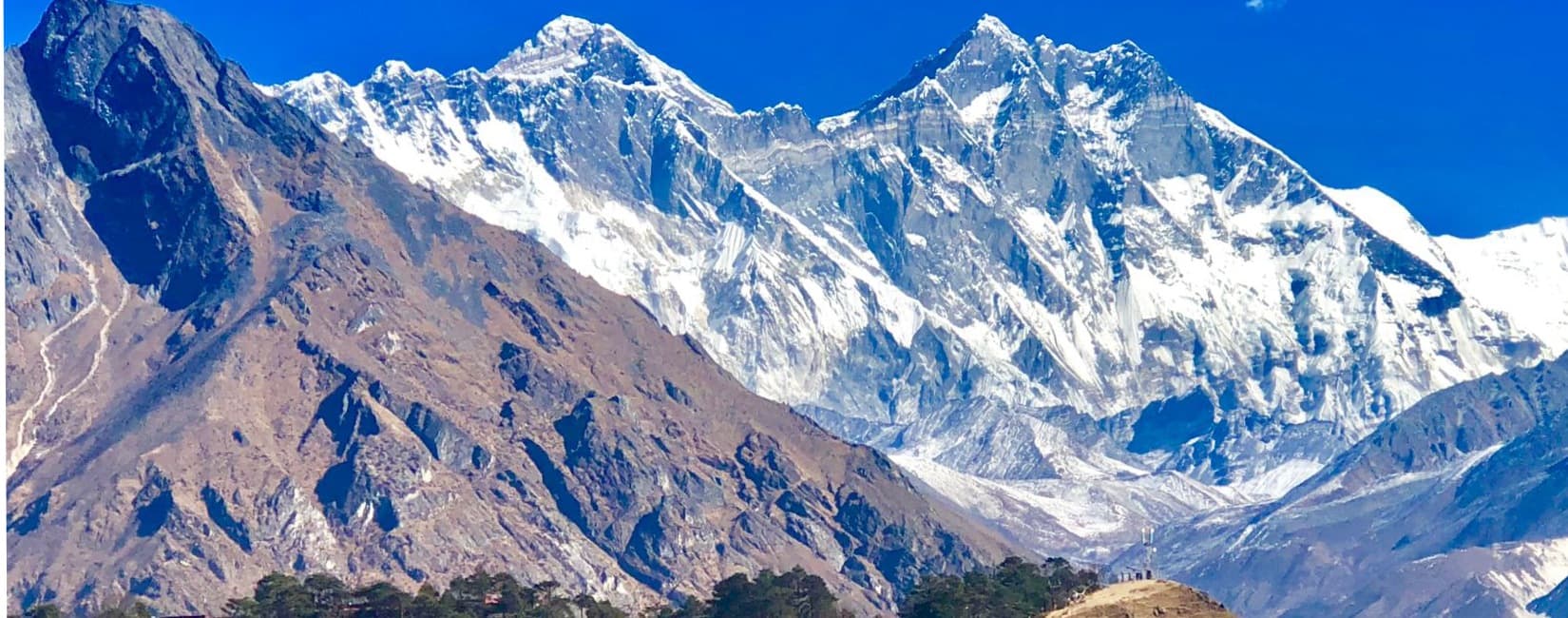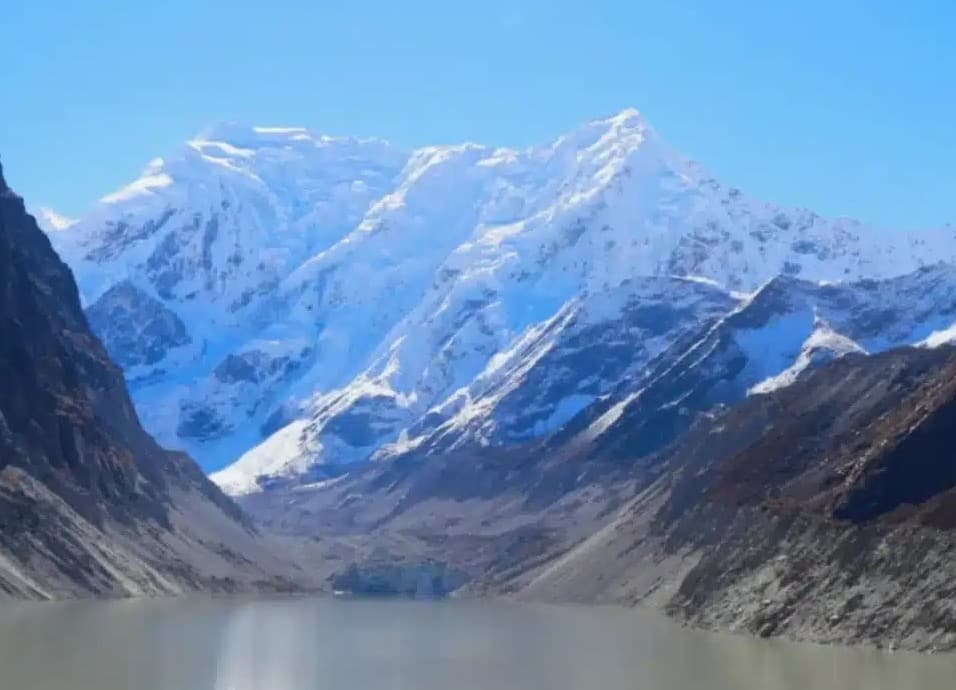Introduction
The Everest Base Camp Trek is one of the most well-known walks in the world. It is a journey in Nepal that takes you high into the Himalayan Mountains. The path leads to the base of Mount Everest, the world's tallest mountain. People feel extremely proud and happy when they reach Everest Base Camp, as it is not just a walk, but an adventure full of beauty and challenge. One big reason why people love this trek is because of the views. Everywhere you look, there are tall snowy peaks, green valleys, swinging bridges, and small villages with kind people. These places look so magical that various trekkers stop often just to take photos. The pictures become a way to keep the memories safe and to show friends and family later.
Photos on this trek are not only about mountains. They are also about colorful houses, prayer flags dancing in the wind, yaks carrying loads, and rivers that shine in the sunlight. Every step of the trek feels like walking inside a giant painting. This is why cameras are always ready in the hands of trekkers. In this article, I will share the best spots where people can take beautiful photos on the Everest Base Camp Trek. From the starting village to the base of Everest itself, each place has something special. Together, these photo spots tell the story of the trek and make it unforgettable.
Best Photography Spots during the EBC Trek
Last Updated in September 2025
Walking to Everest Base Camp is more than just a trek. It feels like stepping into a dream world high in the Himalayas. The first light of morning touches Mount Everest, turning the snowy peak into shining gold. The forests along the way are filled with rhododendron flowers, their bright red and pink colors making the path look magical. Every corner of this journey gives a picture worth keeping forever.
Reaching Everest Base Camp itself is an unforgettable moment. The tallest mountain in the world stands right in front of you, so huge that you feel very small. It is a place where nature shows its true power and beauty. Holding a camera here feels like holding a key to save memories for life. Every photo becomes a story you can share again and again. This trek is not only about mountains. It is also about the people, the villages, the yaks, and the prayer flags flying in the cold wind. Together, they make the Everest Base Camp Trek one of the best adventures for anyone who loves photography.
I still remember when I joined this journey with Heaven Himalaya. Walking through small villages, crossing high bridges, and standing under the giant peaks, I felt like every moment was waiting to be captured. The trek is about 130 kilometers long and takes around 11 days to complete. Yes, it is challenging, but every step brings new views that make you forget the tiredness. For people who love photography, this trek is a gift. From the shining mountains like Ama Dablam and Lhotse to peaceful spots like Tengboche Monastery, each place has its own charm. In this article, we will explore the best photography spots on the Everest Base Camp Trek and share how these places can make your photo collection truly special.
-
Everest Base Camp Trek – A Photographer’s Heaven
The Everest Base Camp Trek is truly a dream for anyone who loves photography. From the very first steps, the trail shows beauty in many forms. There are green forests full of life, waterfalls falling down the rocky cliffs, and the powerful Dudh Koshi River flowing with white water. As you go higher, you see giant snowy mountains that look endless, peaceful monasteries with prayer flags dancing in the wind, and villagers who always welcome you with a smile. Every corner has something new for your heart and your camera.
Many trekkers say that pictures can never fully show the magic of this place. The feeling of standing in front of the world’s highest peaks or hearing the soft bells of yaks on the trail is something beyond a photo. Still, capturing these moments lets you carry a piece of the Himalayas home with you.
When I walked this journey with Heaven Himalaya, I felt like I was living inside a painting. Each day brought something different to see and save rivers, villages, glaciers, and finally, the base of Mount Everest itself. This is my simple attempt to share those moments and take you on a virtual journey through the lens of my trek to Everest Base Camp in Nepal.
-
Tenzing–Hillary Airport in Lukla – The Gateway to Everest Base Camp
Flying to Lukla is the first adventure of the Everest Base Camp trek. The journey begins with a small aircraft that carries about 14 people. The flight from Ramechhap to Lukla takes around 35–40 minutes and feels very special. During the ride, you can look out of the window and see green hills, tiny mountain villages, rivers far below, and snow-covered peaks in the distance. It feels like flying through a painting.
What makes Lukla airport famous is its short runway, only about 527 meters long. On one side, there is a deep valley, and on the other side, there are cliffs and buildings. The plane lands quickly and stops in a very short space, which makes many people feel a rush of excitement and nervous joy at the same time. Some even call it one of the most thrilling airports in the world.
Stepping out of the plane, the cool mountain air welcomes you. The minor airport is busy with trekkers preparing their bags, guides waiting for their groups, and locals moving through the town. From here, many people walk directly to their teahouse in Lukla, where they spend the first night or rest before starting the trek. The streets of Lukla are lined with tea shops, small stores, and colorful houses, giving plenty of chances for photos before the real hike begins.
Tip: Flights to Lukla often get full quickly, particularly in the best trekking months (March–May and October–November). It is also important to pack light, because these small planes have strict weight limits.
-
Colorful Streets of Lukla – The Start Point of the Everest Base Camp Trek
As soon as you step out of Lukla Airport, you arrive on the lively streets of Lukla. The town feels busy, yet calm at the same time. Minor shops line both sides of the stone-paved street, selling trekking gear, warm clothes, snacks, and souvenirs. This is the best place for any last-minute shopping before heading deeper into the mountains.
The street is filled with the cheerful energy of trekkers who are ready to begin their adventure. Some are regulating their backpacks, others are buying walking sticks or woolen hats, and many are simply smiling with excitement. Local people move about their daily work, and their friendly faces add warmth to the atmosphere. Prayer flags hang across the rooftops, adding color to the blue mountain sky above.
Walking through Lukla feels inspiring, almost like the start of a festival. The sound of footsteps, greetings, and shopkeepers calling out makes the place lively. As you leave the colorful roads behind and step onto the trail, the noise fades into the sound of nature. The cool, fresh mountain air fills your lungs, and you realize that the true adventure to Everest Base Camp has just begun.
-
Stunning Views of the Dudhkosi River – On the Way from Phakding to Namche Bazaar
On the second day of the Everest Base Camp trek, the journey from Phakding to Namche Bazaar brings some of the greatest magical views. As we left the teahouse in Phakding, a soft drizzle began to fall. Mist and clouds slowly rose from the valley below, wrapping the hills in a dreamy, white cover. The whole scene looked quiet and mysterious, almost like walking through a painting.
The trail follows the Dudhkosi River, which moves quickly with white, foaming water. Its sound is constantly strong yet soothing, like music in the background of the walk. Walking beside the river feels calm and refreshing, almost meditative, even when the path gets steep and challenging.
Along the way, we crossed several suspension bridges, each covered with prayer flags. The most famous one is the Hillary Suspension Bridge, which is also one of the highest in the region. Standing on this bridge, looking down at the rushing river and then up at the misty cliffs, was a breathtaking moment. The bridge swayed gently under our feet, adding a sense of thrill to the beauty of the view.
This stretch of the trek shows how powerful and peaceful nature can be at the same time, rivers roaring below, clouds drifting above, and trekkers quietly moving forward with excitement in their hearts.
-
Namche Bazaar on the EBC Trek – The Gateway to Khumbu Valley
Namche Bazaar sits at an altitude of about 3,400 meters above sea level. It is one of the liveliest and colorful towns on the Everest Base Camp trail. In the past, Namche was a vital trading center where local people exchanged salt, food, and goods. Today, it has grown into a modern mountain town that welcomes trekkers from all over the world.
The streets of Namche are full of energy. You can find everything here: teahouses, small shops selling trekking gear, cozy bakeries, restaurants, and even a few luxury hotels. There are also cafes and clubs where trekkers unwind in the evenings. After days of walking through quiet villages, Namche feels like a bustling hub in the heart of the Himalayas.
Trekkers usually spend at least one extra day in Namche to acclimatize to the higher altitude. During this rest day, many people explore the surroundings. One of the most special places to visit is the Sherpa Tenzing Norgay Memorial, which honors the legendary mountaineer who first climbed Mount Everest with Sir Edmund Hillary. From here, the views are breathtaking; you can see Everest, Lhotse, and Ama Dablam rising high in the sky. Namche also has a small museum where you can learn more about Sherpa culture, the history of climbing, and the story of Mount Everest. Standing on the viewpoints above Namche, looking at the snow-covered peaks while prayer flags flutter in the wind, is moment greatest trekkers never forget.
-
The Himalayan Giants – Views of Mt. Everest, Lhotse, and Ama Dablam
Day 4 of the Everest Base Camp trek is often remembered as one of the greatest special days. After spending two nights in Namche Bazaar to get used to the higher altitude, the trail continues upward. On this day, the sky opened up clear and blue, giving us perfect views of the Himalayan giants Mount Everest, Mount Lhotse, and Mount Ama Dablam.
For the first time on the trek, Everest came into clear sight. It stood tall and proud in the distance, its snowy peak shining in the sunlight. Next to it was Lhotse, the fourth-highest mountain in the world, and on the other side rose Ama Dablam, known for its sharp, elegant shape that looks almost like a mother’s arm protecting a child. The beauty of these mountains together was beyond words. Standing on the trail and seeing the largest mountain on Earth right in front of you is a feeling that cannot be described easily. Many trekkers stop here for a long time, not just to take photos, but to quietly take in the moment. The sound of the wind, the fluttering of prayer flags, and the sight of these peaks against the deep blue sky make this one of the most unforgettable experiences of the entire journey.
-
Blessings from the Sky – A Buddhist Stupa on the Way to Everest Base Camp
The Khumbu Valley is not only well-known for its mountains but also for its deep Buddhist culture. Along the trek, you see many stupas, Mani stones with prayers carved on them, colorful prayer flags, and old monasteries. These are part of daily life in the Himalayas, and they give the trail a special spiritual feeling. One of the most memorable seconds came when I reached a good-looking white stupa after a tough uphill climb. Surprisingly, for a short while, I was the only person there. The silence of the mountains was disturbed by the soft fluttering of the prayer flags created an atmosphere that felt peaceful and powerful at the same time.
From where I sat on the stone wall of the stupa, I could see the mighty peaks of Everest, Lhotse, and Ama Dablam in the background. The sun was shining warmly, and the cool mountain wind carried the sound of the flags as they danced in the sky. In that moment, the tiredness of the climb disappeared. It felt like being blessed by nature and the culture of the Himalayas together.
-
Tengboche Monastery – The Shangri-La of the Himalayas
Tengboche Monastery, also known as Thyangboche Monastery, is the major Buddhist monastery (Gompa) in the Khumbu Valley. It sits at an altitude of 3,867 meters and is one of the most sacred and most visited places on the Everest Base Camp trek.
When I visited Tengboche, I had the chance to receive blessings from the resident Lamas, the Buddhist spiritual leaders who live and guide here. Sitting inside the monastery, praying in front of the large statues of Tibetan deities, was one of the most peaceful and memorable moments of the whole journey. The calm atmosphere, soft chants, and smell of incense gave the place a very spiritual feeling. The monastery is also celebrated for its architecture and artwork. Inside, you can see ancient wall paintings, colorful murals, thangka paintings, and beautiful sculptures that tell Buddhist stories. With Mount Everest, Lhotse, and Ama Dablam rising in the background, Tengboche feels like a magical gateway between nature and spirituality.
Visiting the monastery is simple and affordable. Entry is donation-based, usually around $1–2, and the best time to visit is during the morning prayers (6–7 AM) when the whole place feels alive with chanting. Out of respect for the culture, visitors should dress modestly and avoid taking photos inside. Around the monastery, there are cozy teahouses where you can stay the night for about $5–10, and meals like dal bhat are usually $3–5.
-
A Lovely Teahouse with the Backdrop of Mt. Lhotse and Ama Dablam
One of the greatest parts of trekking in Nepal is staying in teahouses. These are minor, family-run lodges that feel simple but warm and welcoming. On the way to Everest Base Camp, almost every village has teahouses where trekkers can eat, rest, and sleep for the night. They are like cozy bed-and-breakfasts in the middle of the Himalayas.
I remember staying in one teahouse that had the most incredible view. From the dining room windows and the open yard outside, I could see Mount Lhotse and Mount Ama Dablam standing tall against the sky. The sight of these mountains while sipping a cup of hot tea felt like a dream.
Teahouses usually provide basic rooms with two single beds, blankets, and sometimes shared bathrooms. The food is simple but filling, like dal bhat (rice, lentils, and vegetables), noodles, soups, and tea. Even though the facilities are not fancy, the kindness of the hosts and the mountain views make the stay very special.
Staying in these teahouses is not just about comfort; it is also about being part of the local life. You get to meet the Sherpa families who run them, hear their stories, and enjoy the warmth of their hospitality. With mountains like Ama Dablam and Lhotse in the background, every teahouse feels like a home in the clouds.
-
Ama Dablam – The Constant Companion on the Trek
Most trekkers come to the Everest Base Camp trail excited to see Mount Everest, the highest mountain in the world. But for me, one of the major highlights was seeing Ama Dablam, often called the “Matterhorn of Asia.” This mountain, with its sharp ridges and unique shape, is considered one of the most beautiful peaks on Earth.
Ama Dablam stands at 6,812 meters and is well-known among climbers as a very technical and difficult mountain. Its steep faces and sharp ridges demand great climbing skills, experience, and strength. Even though most trekkers never climb it, just walking below it and seeing it from different angles is an experience to remember.
One of the special things about Ama Dablam is that you don’t just see it once; you see it again and again during the trek. From Namche Bazaar to Tengboche, Dingboche, and even higher villages like Lobuche and Gorakshep, Ama Dablam is always there in the background. Each place shows a new side of the mountain. Some days it expresses soft and glowing in the morning sun, while other times it looks sharp and mighty under the blue sky.
Walking from one teahouse to another, I always felt like Ama Dablam was walking along with me, almost like a guardian of the Khumbu Valley. It is not just a mountain; it becomes part of the journey itself. For numerous trekkers, Ama Dablam is the mountain that stays closest to their hearts, even more than Everest.
-
A Porter Resting Near a Mani Stone with Mt. Lhotse in the Background
While walking towards Dingboche on the Everest Base Camp trail, I came across a scene that touched me deeply. A porter had stopped to catch his breath and was resting near a Mani stone, with the mighty Mount Lhotse standing high in the background. It was a simple yet influential second that showed the real life of the Himalayas.
Life in the mountains is never easy. Because the villages are remote and at high altitude, almost everything has to be carried by porters or transported on yaks and mules. On this trek, you will often see porters moving from one village to another with heavy loads tied to their backs and heads. Some carry supplies for the local people, while others carry trekking bags and equipment for travelers like us.
What amazed me most was their strength and endurance. Without fancy trekking shoes or expensive gear, they walk long distances every day, sometimes in the roughest weather conditions. Their loads often weigh as much as 30–40 kilograms, yet they move with steady steps on rocky trails that test even the fittest trekkers.
These porters are truly the backbone of trekking and mountaineering in Nepal. Without them, it would be impossible for so many people to like the beauty of the Himalayas. Watching them work with such dedication and simplicity makes you respect and admire them even additional. They remind us that behind every successful trek, countless unsung heroes make it possible.
-
Stunning Himalayan Villages
The Everest Base Camp trek is not only about seeing tall mountains and snowy peaks. Along the way, you also pass through beautiful Himalayan villages where people live simple but inspiring lives. Staying in these villages gives trekkers a chance to experience true Nepalese hospitality and learn about the culture of the mountains.
Villages like Lukla and Namche Bazaar are very popular among trekkers. Lukla is the entry point to the trek, while Namche is known as the “gateway to Everest” with its busy markets, bakeries, and even modern facilities. Both have a lively atmosphere, full of trekkers from around the world.
But the trail also takes you to smaller, quieter villages that feel more traditional. One such village is Dingboche, sitting at an altitude of about 4,400 meters. Dingboche is one of the highest permanent settlements in Nepal. Life here is slow and simple, with open farmlands, stone houses, small lodges, and monasteries.
Staying in a place like Dingboche feels special. You see local people working in their fields, hear the sound of prayer flags fluttering in the wind, and enjoy warm meals in cozy teahouses. The air is crisp and clear, and the views of the mountains are breathtaking. It’s also a popular stop for acclimatization, where trekkers spend an extra day adjusting to the high altitude.
These Himalayan villages may be small, but they leave a big impression. They show you a lifestyle that is deeply connected to nature, community, and tradition, making the trek not just a journey through mountains, but also a journey into culture.
-
The Ever-Changing Landscapes and Stunning Valleys
One of the most amazing things about the Everest Base Camp trek is how quickly the landscapes change. At the beginning of the journey, the trail takes you through lush green forests. You walk past tall trees, hear the sound of birds, and cross small streams and waterfalls that sparkle in the sunlight. The air feels fresh, and the surroundings are full of life.
As you climb higher, the scenery begins to look different. The forests slowly fade, and wide valleys open up in front of you. These valleys are surrounded by giant snow-covered peaks that seem to rise straight into the sky. Walking through them makes you feel small but also deeply connected to nature.
With each step upward, the colors of the land change, too. Green fields turn into rocky trails, and higher up, you see brown and gray landscapes mixed with patches of snow. It feels like walking from one world into another, all within the same trek.
This constant change is what makes the journey so special. Every day brings something new for the eyes and the camera, whether it’s forests, rivers, valleys, or the mighty Himalayan peaks standing proudly above.
-
Thukla Pass Memorial
One of the most emotional parts of the Everest Base Camp trek is reaching the Thukla Pass Memorial. This place, at an altitude of about 4,830 meters, is built in memory of the mountaineers and Sherpas who lost their lives while trying to climb Mount Everest.
As you walk up the steep trail toward the pass, rows of stone memorials slowly come into view. Each one has names, dates, and sometimes personal messages written on it. Many trekkers stop here for a while, not just to rest but also to reflect. The quiet wind, the prayer flags fluttering, and the sight of these memorials against the backdrop of the towering Himalayas create a very powerful atmosphere.
It is a reminder of both the beauty and the danger of the mountains. For climbers, Everest is a dream, but it also comes with risks. The memorials at Thukla Pass honor the courage and spirit of those who dared to follow that dream, including many Sherpas who played an important role in every expedition.
Standing there, I felt humbled and emotional. It is a place of respect, where trekkers bow their heads, take a deep breath, and carry the memory of these brave souls forward on their own journey.
-
Trek to Lobuche
The trek from Dingboche to Lobuche is one of the most challenging yet rewarding parts of the Everest Base Camp journey. As we left Dingboche, the trail slowly climbed higher, and the air felt thinner with every step. Breathing became harder, and walking took more effort.
The path passed through rocky glacial moraines—huge piles of rocks and boulders left behind by moving glaciers. Walking here was not easy, as the ground was uneven and the climb was steady. But with every turn, the mountains seemed to rise closer and taller around us. Snow-covered peaks stood proudly on all sides, making the hard walk worth it.
By the time we reached Lobuche, the landscape had completely changed from the green valleys of the lower regions. Everything felt rawer and wilder: rocky trails, icy winds, and endless views of white peaks. Even though the trek was tiring, the beauty of the surroundings gave us the strength to keep moving forward.
Lobuche, sitting at a high altitude, is one of the last stops before reaching Everest Base Camp. The small cluster of teahouses here offers shelter and warmth, where trekkers gather to rest, eat, and prepare for the final push towards their dream destination.
-
Magical Sunset Views Over Nuptse Peak from Lobuche Village
One of the greatest unforgettable moments in Lobuche came at sunset. As the day came to an end, the last rays of the sun touched the snowy summit of Nuptse, and the entire peak began to glow in golden light. Within just a few minutes, the colors changed first golden, then orange, and finally faded into soft pink before the mountain turned silver under the evening sky.
I clicked two pictures only minutes apart, but each looked completely different. The magic of the sunset over Nuptse was not only about the light but also about the silence of the mountains around. The air was cold and still, and all I could hear was the wind as the peaks slowly disappeared into the night.
Watching this view from Lobuche made me realize how quickly nature can transform. Moments like these remind you why the Himalayas are so special. Every day brings a new surprise, and every mountain shows a new face.
-
Nature’s Reflections
As we began our walk toward Gorakshep, the last village before Everest Base Camp, the trail surprised us with a magical sight. Small ponds and water bodies along the way were partly frozen, shining under the morning sun. The sunlight touched the icy surface and created mirror-like reflections, making the whole scene look dreamy and unreal.
From where we stood, the mighty Mt. Pumori appeared in the distance, peeking out from behind a small hill. The mountain looked even more beautiful in the reflection, almost as if two world’s one real and one in the water, were meeting together.
The silence of the morning, the crunch of our boots on the frozen ground, and the sparkling reflections made this moment feel like stepping into a painting. It was a gentle reminder of how the Himalayas are not only about big mountains but also about the small, magical details that make every step so special.
-
The Grand Himalayan Panorama
The walk to Gorakshep was one of the toughest and most demanding parts of the Everest Base Camp trek. Every step felt heavier because of the high altitude, and the thin air made it harder to breathe. The rocky trail became steeper as we got closer to our destination, and the ground beneath us was rough and uneven, reminding us that we were truly in the heart of the Himalayas.
But along with the challenge came an incredible reward. Right in front of us stood the majestic Mt. Pumori, shining brightly under the clear sky. On one side, the towering Nuptse wall stretched endlessly, its icy ridges glowing in shades of white and silver. Each step, though tiring, gave us more and more breathtaking views, almost as if the mountains themselves were encouraging us to keep going.
As we paused to catch our breath, the landscape opened into a grand panorama of snow-covered peaks, glaciers, and endless valleys. The silence of the high mountains mixed with the crunch of our boots created a powerful moment of connection with nature. Despite the fatigue, we felt inspired and humbled, surrounded by the raw beauty of the Himalayas.
-
The Everest Base Camp and Kala Patthar
Finally, after days of walking through forests, valleys, villages, and high mountain passes, we reached the ultimate goal, the Everest Base Camp. Standing at the foot of the world’s highest mountain felt surreal. The camp itself was dotted with colorful prayer flags fluttering in the cold wind, set against the backdrop of the mighty Khumbu Icefall. Though you cannot see the peak of Everest from the base camp itself, the energy of the place is extraordinary. You feel a deep sense of achievement, knowing that this is the very ground where mountaineers prepare to climb to the top of the world.
Reaching base camp is not just about the view; it’s about the journey. Every step taken to get there makes the moment even more special. The chilly air, the sound of the crunching ice, and the company of fellow trekkers all add to the unforgettable experience.
But the highlight of the trek is not only the base camp. Early the next morning, we hiked up to Kala Patthar, a rocky hill standing at 5,545 meters. This climb is tough, the air is thin, and every breath feels heavy, but the reward is unmatched. From the top, you get one of the best panoramic views in the world. The sun slowly rises, casting golden light on the summit of Everest, while nearby peaks like Lhotse, Nuptse, and Ama Dablam glow in morning colors.
Standing there, watching the world’s highest mountain right in front of you, is an emotional moment. It is not just a view, it is a memory etched forever, a reward for all the hard work and determination of the journey.
-
The Journey Back to Civilization
After the thrill of standing at Everest Base Camp and witnessing sunrise from Kala Patthar, it was finally time to head back. The descent felt dissimilar from the climb. Going down to lower altitudes brought a sense of relief; you could feel more oxygen in the air, and each breath came easier than before. The fatigue of the long trek was still there, but the lighter air gave us extra energy to continue.
On the way back, we covered longer distances in a single day compared to the slow and steady climb up. Villages we had passed earlier looked warmer and additional welcoming this time, almost like familiar friends. The sound of the rushing Dudh Koshi River, the sight of suspension bridges swaying in the wind, and the fluttering prayer flags reminded us how much beauty the trail still had to offer even on the return.
As we retraced our steps towards Lukla, the thought of hot showers, soft beds, and the comfort of city life gave us extra motivation. Yet, a part of us felt nostalgic knowing the journey was coming to an end. The quiet teahouses, the warm smiles of Sherpa hosts, and the grand Himalayan views had become part of our daily rhythm.
Finally, reaching Lukla once again felt like closing a full circle. From here, a short flight would soon take us back to Kathmandu and into the heart of civilization. The adventure had ended, but the memories of the mountains, the people, and the experiences would stay forever.
-
Kathmandu
And finally, it was time to bid farewell to the mighty mountains. After returning from Lukla, I spent a couple of days in Kathmandu before heading home. This was a perfect way to end the journey, as it gave me a chance to see another side of Nepal beyond the mountains.
In Kathmandu, I visited some of the city’s famous cultural and historical attractions. Walking through the bustling streets, I visited UNESCO World Heritage Sites like Swayambhunath (the Monkey Temple), Boudhanath Stupa, and Pashupatinath Temple. Each place had its own unique charm, colorful prayer flags, ancient temples, and the smell of incense filling the air.
The lively squares, old palaces, and local markets gave me a glimpse of Nepal’s rich history and traditions. After days of trekking in quiet valleys and villages, the vibrant energy of the capital felt refreshing and exciting.
-
Conclusion
The Everest Base Camp Trek is more than just a walk in the mountains. It is a life-changing adventure through Nepal’s majestic Himalayas. From the exciting flight to Lukla to the peaceful moments at Tengboche Monastery, and from the vibrant Sherpa villages to the stunning views of Mt. Everest, Lhotse, and Ama Dablam, every step of the journey feels special.
For photographers, this trek is full of picture-perfect moments. For trekkers, it offers the thrill of high-altitude trails and changing landscapes. Covering about 130 kilometers, this adventure gives memories that will stay with you forever.
If you are dreaming about experiencing the Everest Base Camp Trek, Heaven Himalaya is here to lead you. With expert guides, well-planned itineraries, and warm hospitality, we make sure your Himalayan journey is safe, enjoyable, and unforgettable.
Contact us at info@heavenhimalaya.com to start planning your Everest adventure today.
FAQs about the Everest Base Camp Trek
How long does the Everest Base Camp Trek take?
The Everest Base Camp Trek usually takes around 11 to 14 days, depending on the itinerary. The journey covers about 130 kilometers (round trip). Most trekkers fly to Lukla and then follow the trail to Everest Base Camp, with enough acclimatization days included to adjust to the altitude. The length can vary depending on walking speed, rest days, and weather conditions.
What is the best time to trek to Everest Base Camp?
The best time for the Everest Base Camp Trek is during spring (March to May) and autumn (September to November). In these seasons, the weather is stable, the skies are clear, and the mountain views are breathtaking. Spring offers blooming rhododendrons, while autumn gives crisp air and excellent visibility. Winter (December–February) is colder, and summer/monsoon (June–August) brings heavy rains, making the trek more challenging.
How difficult is the Everest Base Camp Trek?
The trek is considered moderate to challenging. It does not require professional climbing skills, but trekkers should be prepared for long walking days (5–7 hours daily), steep ascents, and high altitude. The highest point is Kala Patthar at 5,545 meters, which can be tough due to the thin air. With proper preparation, training, and acclimatization, most people with average fitness can complete the trek successfully.
Do I need a guide and porter for the trek?
While it is possible to trek independently, many people prefer to hire a guide and porter. A guide helps with navigation, cultural insights, and safety, while a porter carries your heavy backpack, making the trek more enjoyable. Hiring local staff also supports the communities of the Khumbu region. Companies like Heaven Himalaya provide experienced guides and porters who ensure a smooth trekking experience.
What kind of accommodation and food can I expect?
Along the trail, trekkers stay in teahouses, small lodges run by local families. These provide a basic room, usually with twin beds, and shared bathrooms. Food is served in a common dining hall, with popular options like dal bhat (rice and lentils), noodles, soups, pasta, eggs, and sometimes pizza or bakery items in larger villages. The food is simple but filling, and hot drinks like tea and coffee are available.
How do I prepare for the Everest Base Camp Trek?
Preparation is very important. Trekkers should do cardio exercises (like running, cycling, swimming) and strength training for at least two months before the trek. Practice long hikes with a backpack to build stamina. Mental preparation is also key, as the trek involves walking several hours every day in high-altitude conditions. Packing the right gear, warm clothes, trekking boots, sleeping bag, and layers is also necessary.
What permits are required for the trek?
Trekkers need two main permits: the Sagarmatha National Park Entry Permit and the Khumbu Pasang Lhamu Rural Municipality Permit. These are checked at various points along the trail. If you book through a trekking company like Heaven Himalaya, they arrange all permits for you, so you don’t need to worry about the paperwork.
What is altitude sickness, and how can I avoid it?
Altitude sickness happens when your body struggles to adapt to high altitudes. Symptoms include headache, dizziness, nausea, and shortness of breath. To avoid it, trekkers should walk slowly, drink plenty of water, and take acclimatization days (especially in Namche Bazaar and Dingboche). If symptoms get worse, descending to a lower altitude is the safest solution.
Can beginners do the Everest Base Camp Trek?
Yes, beginners can do the trek with proper preparation and determination. Many first-time trekkers have completed the journey. However, it is important to have a good level of physical fitness, follow acclimatization rules, and trek with an experienced guide to ensure safety.
How much does the Everest Base Camp Trek cost?
The cost depends on the package and services. On average, the trek costs between $1,200 $2,000 USD, which includes permits, flights to Lukla, accommodation, food, guide, and porter services. Luxury treks with better lodges and facilities can cost more. Booking with a trusted company like Heaven Himalaya ensures good value and reliable services.










